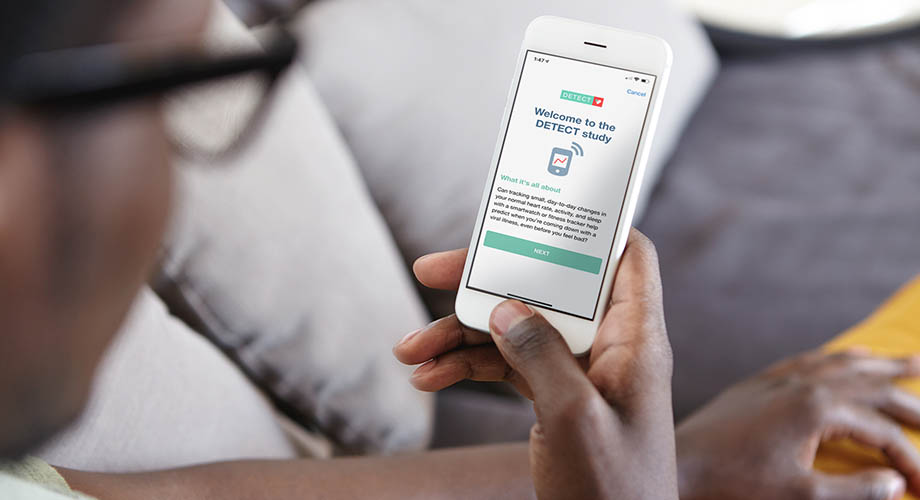A grant from the New York-based foundation will fuel expansion of DETECT, Scripps Research’s sensor-based study for real-time digital detection of viral illness.
LA JOLLA, CA—Scientists at the Scripps Research Digital Trials Center are collaborating with The Rockefeller Foundation to expand efforts to create a sensor-based early warning system for COVID-19 and other viral outbreaks. Efforts will center on expanding and refining Scripps Research’s ongoing DETECT study, which has already enrolled more than 38,000 participants across the United States.
Bolstered by a new grant from The Rockefeller Foundation, the DETECT team will expand outreach efforts to further increase participation, with a primary focus on underrepresented and high-risk communities across San Diego County.
The scientists also received support in the form of computing credits from the Amazon Web Services (AWS) Diagnostic Development Initiative.
The app-based DETECT study, launched in March 2020, uses sensor data from smartwatches and activity trackers of consenting participants to gain new insights into physiological and behavioral changes associated with viral illness—and more recently, physiological response to vaccines. The team’s goal is to detect COVID-19 or other illnesses before symptoms appear.
“A larger and more diverse pool of participants will allow us to refine and validate our predictive model for identifying viral illness activity, including COVID-19 and seasonal flu, based on changes in heart rate, sleep and activity,” says Jennifer Radin, PhD, the Scripps Research Translational Institute (SRTI) epidemiologist leading the study. “By targeting our efforts in San Diego, where we’ve already enrolled over 3,000 local participants, we hope to scale to a level where we can track population-level viral illness in real-time in a geographically defined area.”
An early analysis of DETECT data, published last fall in Nature Medicine, showed that the information captured by wearable devices can significantly improve scientists’ ability to identify infections, compared with relying on reported symptoms alone.
The Scripps Research team hopes the approach can eventually supplement traditional disease-surveillance methods—which often rely on data from healthcare institutions and testing facilities—to identify outbreaks faster and with greater geographic accuracy. This would enable public health officials to contain deadly viruses more quickly.
An innovative collaboration
Throughout the COVID-19 pandemic, scientists at Scripps Research have collaborated with their peers at The Rockefeller Foundation in New York to respond to the many challenges that have emerged.
Eric Topol, MD, founder and director of the Scripps Research Translational Institute, contributed to The Rockefeller Foundation’s National COVID-19 Testing Action Plan, as well as an updated version of the report. Topol and Kristian Andersen, PhD, director of Infectious Disease Genomics at SRTI, also provided their expertise for the Foundation’s national disease surveillance plan, which calls for using genomic technologies and other sophisticated tools to detect and track viral threats.
“When it comes to preparing for and responding to disease outbreaks, the need for innovation has been clear even before the COVID-19 pandemic,” says Rick Bright, PhD, senior vice president of Pandemic Prevention and Response at The Rockefeller Foundation. “We envision a federated global early warning system that considers a variety of data streams—from genomic sequencing and wastewater surveillance to cell phone mobility and wearable sensors—and can produce insights that can be used to stop disease outbreaks in their first 100 days.”
Keeping an eye on viral threats
In addition to helping public health officials in the United States improve their response to outbreaks, the team envisions a use for the approach in other parts of the world.
While the development of highly effective vaccines in record time has provided many countries a powerful tool for reining in COVID-19, the global situation remains dire. In many areas, vaccines are not accessible, and the virus continues to spread uncontrolled, raising the risk that dangerous new variants will emerge.
Wearable sensor-based technologies can help, allowing public health officials to identify outbreaks of COVID-19, the seasonal flu or the next novel virus of pandemic potential. They also can help track physiological response to vaccines and treatments.
After validating the sensor-based virus surveillance model in San Diego, the team plans to roll it out more broadly, with an emphasis on regions with limited capacity for traditional disease surveillance methods.
“We are delighted to continue our collaboration with The Rockefeller Foundation and grateful for the support from AWS,” Topol says. “We look forward to taking DETECT and digital disease surveillance to the next level.”
The Scripps Research Digital Trials Center leads groundbreaking studies that address the world’s most pressing health concerns. As pioneers of the “site-less” clinical trial, the center leverage rapidly evolving digital health technologies to re-engineer the clinical trial experience around the participant, rather than the research site.
Enrollment in DETECT is open to anyone over the age of 18 in the United States. To learn more, visit detectstudy.org.



